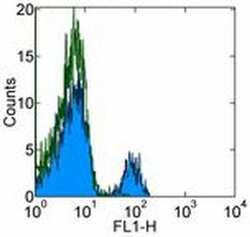Antibody data
- Antibody Data
- Antigen structure
- References [4]
- Comments [0]
- Validations
- Flow cytometry [1]
Submit
Validation data
Reference
Comment
Report error
- Product number
- 14-1809-82 - Provider product page

- Provider
- Invitrogen Antibodies
- Product name
- CD180 (RP105) Monoclonal Antibody (MHR73-11), eBioscience™
- Antibody type
- Monoclonal
- Antigen
- Other
- Description
- Description: The MHR73-11 monoclonal antibody reacts with human CD180 (RP105). This 105 kDa type I transmembrane molecule is a member of the TLR family of proteins characterized by an extracellular domain with leucine-rich repeats and a cytoplasmic domain with homology to the type I IL-1 receptor. RP105 physically associates with another molecule called MD-1 and is expressed on B, monocytes/macrophages, and dendritic cells. Histological studies show that RP105 is expressed mainly on mature B cells in mantle zones, while germinal center cells are either dull or negative. The RP105/MD-1 complex in concert with TLR4 mediates B cell recognition and signaling of LPS. MHR73-11 activates B cells, leading to increases in cell size, expression of the costimulatory molecule CD80, and DNA synthesis. Moreover, ligation of RP105 protects B cells from irradiation- or dexamethasone-induced apoptosis. Thus, RP105 is a signal transduction molecule and plays a role in regulation of B cell growth and death. A significant proportion of circulating B cells in SLE patients is RP105 negative. Loss of RP105 is associated with B cell activation and increased disease activity in SLE patients. Applications Reported: MHR73-11 has been reported for use in flow cytometric analysis, immunoprecipitation, and immunohistochemical staining. MHR73-11 has also been reported in in vitro functional studies. (Please use Functional Grade purified MHR73-11, Product # 16-1809, in functional assays). Applications Tested: The MHR73-11 antibody has been tested by flow cytometric analysis of normal human peripheral blood cells. This can be used at less than or equal to 1 µg per test. A test is defined as the amount (µg) of antibody that will stain a cell sample in a final volume of 100 µL. Cell number should be determined empirically but can range from 10^5 to 10^8 cells/test. It is recommended that the antibody be carefully titrated for optimal performance in the assay of interest. Purity: Greater than 90%, as determined by SDS-PAGE. Aggregation: Less than 10%, as determined by HPLC. Filtration: 0.2 µm post-manufacturing filtered.
- Reactivity
- Human
- Host
- Mouse
- Isotype
- IgG
- Antibody clone number
- MHR73-11
- Vial size
- 100 μg
- Concentration
- 0.5 mg/mL
- Storage
- 4°C
Submitted references Human IgE(+) B cells are derived from T cell-dependent and T cell-independent pathways.
B cells lacking RP105, a novel B cell antigen, in systemic lupus erythematosus.
RP105 is associated with MD-1 and transmits an activation signal in human B cells.
Molecular cloning of a human RP105 homologue and chromosomal localization of the mouse and human RP105 genes (Ly64 and LY64).
Berkowska MA, Heeringa JJ, Hajdarbegovic E, van der Burg M, Thio HB, van Hagen PM, Boon L, Orfao A, van Dongen JJ, van Zelm MC
The Journal of allergy and clinical immunology 2014 Sep;134(3):688-697.e6
The Journal of allergy and clinical immunology 2014 Sep;134(3):688-697.e6
B cells lacking RP105, a novel B cell antigen, in systemic lupus erythematosus.
Koarada S, Tada Y, Ushiyama O, Morito F, Suzuki N, Ohta A, Miyake K, Kimoto M, Nagasawa K
Arthritis and rheumatism 1999 Dec;42(12):2593-600
Arthritis and rheumatism 1999 Dec;42(12):2593-600
RP105 is associated with MD-1 and transmits an activation signal in human B cells.
Miura Y, Shimazu R, Miyake K, Akashi S, Ogata H, Yamashita Y, Narisawa Y, Kimoto M
Blood 1998 Oct 15;92(8):2815-22
Blood 1998 Oct 15;92(8):2815-22
Molecular cloning of a human RP105 homologue and chromosomal localization of the mouse and human RP105 genes (Ly64 and LY64).
Miura Y, Miyake K, Yamashita Y, Shimazu R, Copeland NG, Gilbert DJ, Jenkins NA, Inazawa J, Abe T, Kimoto M
Genomics 1996 Dec 15;38(3):299-304
Genomics 1996 Dec 15;38(3):299-304
No comments: Submit comment
Supportive validation
- Submitted by
- Invitrogen Antibodies (provider)
- Main image

- Experimental details
- Staining of normal human peripheral blood cells with 1 µg of Mouse IgG1 kappa Isotype Control Purified (Product # 14-4714-82) (open histogram) or 1 µg of Anti-Human CD180 (RP105) Purified (filled histogram) followed by Anti-Mouse IgG FITC (Product # 11-4011-85). Cells in the lymphocyte gate were used for analysis.
 Explore
Explore Validate
Validate Learn
Learn Immunoprecipitation
Immunoprecipitation Flow cytometry
Flow cytometry